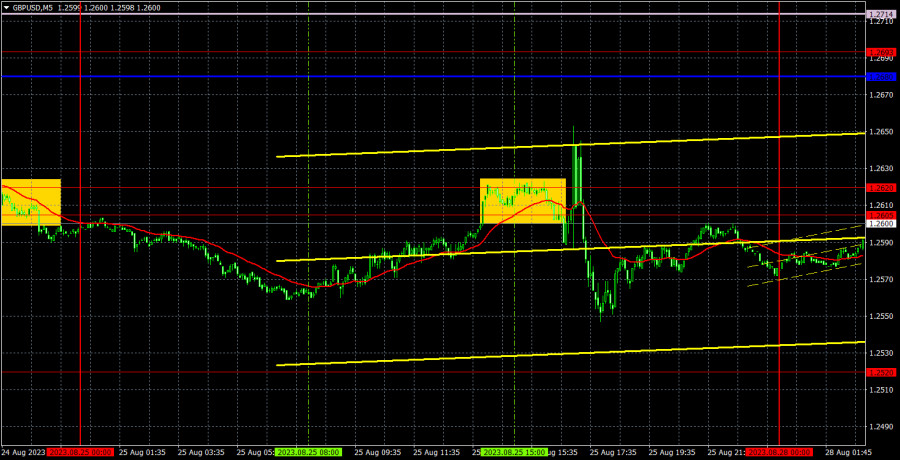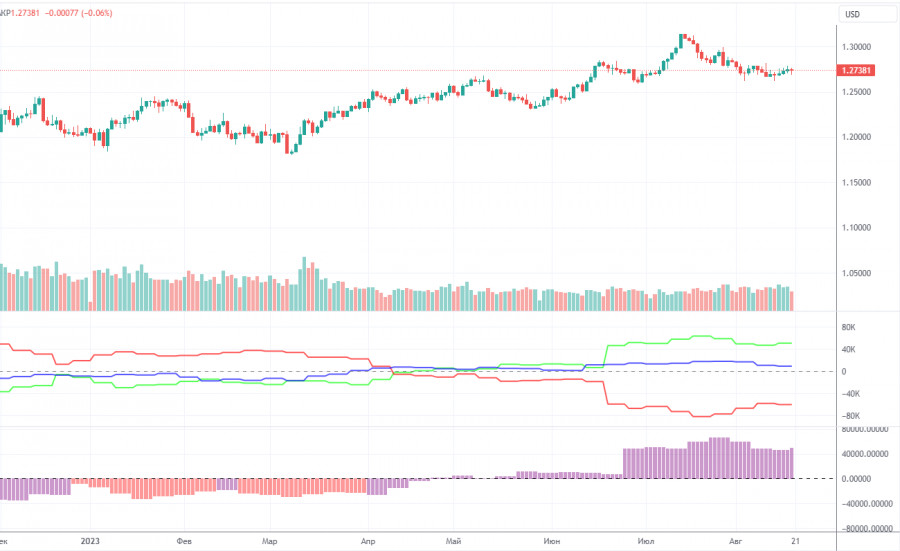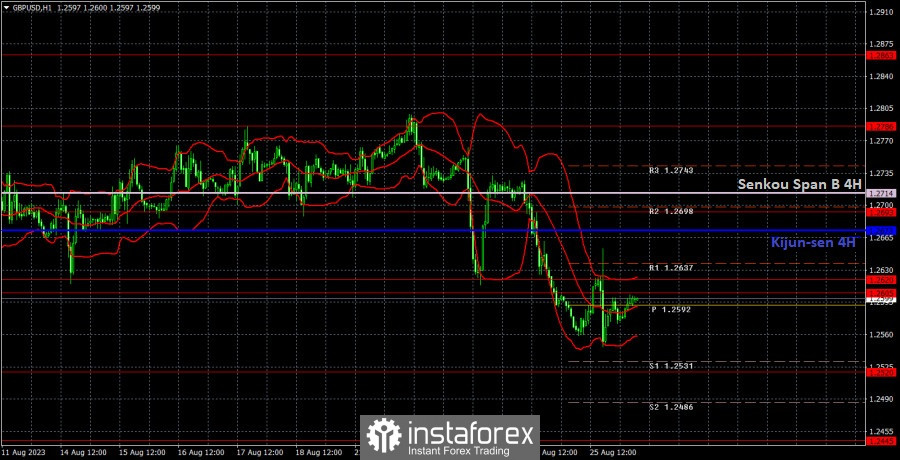

On Friday, GBP/USD showed rather chaotic movements. The price managed to rise and fall. Such fluctuations can be easily explained. Federal Reserve Chair Jerome Powell's speech was hardly surprising, as no member of the Bank's monetary committee had previously stated that the monetary tightening cycle was over. Therefore, when Powell mentioned a potential rate hike in the upcoming meetings, nobody was taken aback. However, it still served as a reason for new long positions on the dollar, which took place. There was nothing noteworthy about Friday's economic reports, and in the medium term, we expect the dollar to strengthen further.
Speaking of Friday's trading signals, it's extremely difficult to pinpoint any. The first signal formed around 1.2605-1.2620, but it was established half an hour before Powell started his speech, which made it risky to enter the market. What followed resembled a rollercoaster, hence any signal should have been disregarded. One could consider opening a short position since Powell's stance did support the dollar, but the challenge was also in seizing the moment to do so. It's unlikely that anyone was tracking Powell's speech in real-time. Therefore, the best thing to do was to stay out of the market.
COT report:
According to the latest report, the non-commercial group of traders opened 7,500 long positions and closed 600 short ones. Thus, the net position of non-commercial traders increased by 8,100 positions in a week. The net position has been steadily growing over the past 11 months as well as the pound sterling. Now, the net position has advanced markedly. This is why the pair will hardly maintain its bullish momentum. I believe that a long and protracted downward movement should begin. COT reports signal a slight growth of the British currency but it will not be able to rise in the long term. There are no drivers for opening new long positions. Slowly, sell signals are emerging on the 4-hour and 24-hour charts.
The British currency has already grown by a total of 2,800 pips, from its absolute lows reached last year, which is a significant increase. Without a downward correction, the continuation of the uptrend will be illogical. We are not against the uptrend; we just believe a solid correction is needed first. The market perceives the fundamental background one-sidedly, ignoring any data in favor of the dollar. The Non-commercial group of traders has a total of 98,000 long positions and 38,900 short ones. I remain skeptical about the long-term growth of the pound sterling, and the market has recently begun to pay attention to short positions.
Analysis of GBP/USD 1H
On the 1H chart, the pound/dollar pair has left the sideways channel where it was trading for three weeks. The pair can fall further, which is what we expect it to do. Currently, the macroeconomic and fundamental background is not as important for medium-term movement, as the market has long since processed all the bullish factors for the pound. However, this week there will be a lot of important data, so the pound can still rise.
On August 28, traders should pay attention to the following key levels: 1.2429-1.2445, 1.2520, 1.2605-1.2620, 1.2693, 1.2786, 1.2863, 1.2981-1.2987. Senkou Span B lines (1.2714) and Kijun-sen (1.2673) lines can also be sources of signals, e.g. rebounds and breakout of these levels and lines. It is recommended to set the Stop Loss orders at the breakeven level when the price moves in the right direction by 20 pips. The lines of the Ichimoku indicator can move during the day, which should be taken into account when determining trading signals. There are support and resistance levels that can be used to lock in profits.
On Monday, there's nothing particularly noteworthy slated in the UK and the US. Volatility may be low, and there might be no trend. Nonetheless, we won't be surprised if the pound continues to fall. The market can trade without macroeconomics and fundamentals.
Description of the chart:Support and resistance levels are thick red lines near which the trend may end. They do not provide trading signals;
The Kijun-sen and Senkou Span B lines are the lines of the Ichimoku indicator, plotted to the 1H timeframe from the 4H one. They provide trading signals;
Extreme levels are thin red lines from which the price bounced earlier. They provide trading signals;
Yellow lines are trend lines, trend channels, and any other technical patterns;
Indicator 1 on the COT charts is the net position size for each category of traders;
Indicator 2 on the COT charts is the net position size for the Non-commercial group.